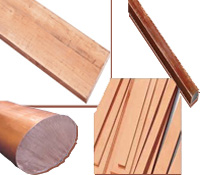C110 Copper - Flat,Square,Round

Characteristics
Alloy C11000 also known as electrolytic tough pitch (ETP) copper, is used most in electric current carrying applications. 110 Copper is 99.9% pure copper with an electrical conductivity rating of 100+ % IACS. Conductivity, corrosion resistance, and ductility makes 110 Copper very versatile over a broad range of applications. 110 Copper is anneal resistant, and is usually supplied in the 1/8H (hard) or 1/4H condition. 110 copper is available in rounds, squares, flats, sheets and plates. The 110 copper bar with H04 temper is unpolished and has a standard tolerance. The 110 copper alloy is 99.9% pure copper and has high conductivity and formability. The material has an H04 temper, meaning it has been cold worked to a hard temper.
C11000 ETP (Electronic Tough Pitch) Copper is one of the most popular copper alloys. 110 Copper is used in a wide variety of applications in a number of industries. It is utilized due to its high electrical conductivity and its range of fabrication methods. C11000 ETP Copper can be bent, soldered, drilled, peened, rivited and formed. It is not a good machining metal with a machinability rating of 20. C110 also has a high thermal conductivity. It is an Oxygen free copper.
C11000 has excellent corrosion resistance to weathering and very good resistance to many chemicals. It is often used specifically for corrosion resistance. It is suitable for use with most waters, and can be used underground because it resists soil corrosion. It resists non-oxidizing mineral and organic acids, caustic solutions and saline solutions. Depending on concentration and specific conditions of exposure, copper generally resists acids.
CuETP (CuETP1) is the most common copper. It is universal for electrical applications.C11000C (Electrolytic Tough Pitch Copper) is an electrolytic refined copper widely used for electrical and electronic applications. CuETP has the properties required in all applications with a hydrogen-free atmosphere. In the presence of H2 and heat all oxygen-bearing coppers suffer from so-called hydrogen embrittlement. C110 copper has the highest electrical conductivity of any metal except silver. The copper alloys are generally red or pinkish in color. They are known for their malleability and ductility (ease of working), heat conductivity, and electrical conductivity. Copper does develop an oxide layer, or patina, when exposed to water.
- Specifications = ASTM B133, SAE J461, SAE J463, QQ-C-502C, QQ-B-575
- Mechanical Properties : Tensile Strength(psi) 32,000 Yield Strength(psi) 10,000 .
Applications
The dominant use of this alloy is in electrical conductors, and is widely used for gaskets, switches, terminals and connectors, transformers, electronic parts, ball floats, drawn and spun hollow ware. Electrical and heat exchangers. C110 is a commercial copper which is more economical than C102. It has good solderability and corrosion resistance and is used for high current applications. It has an extremely wide range of applications based on its conductivity, corrosion resistance, workability, and beauty.
C110 Copper has a broad range of uses, including plumbing fittings, electrical components, wave guides, base plates, bus bars, heat exchanger components, blade and ring terminals, cables, power transmission components, automotive spark plug electrodes, resistance welding electrodes, terminals, and high conductivity items for use at raised temperatures. Both hot and cold forming characteristics are excellent and can be used wherever extensive machining is not required.
C110 Copper Pictures
